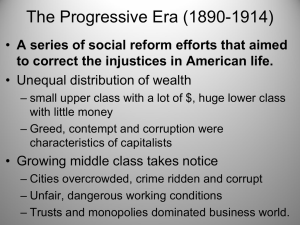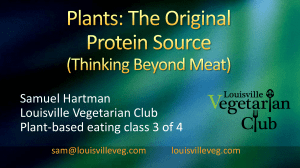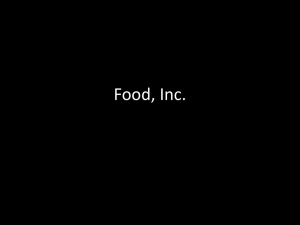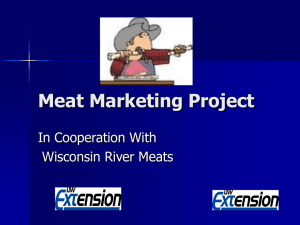Meat - Animals and Society Institute
advertisement
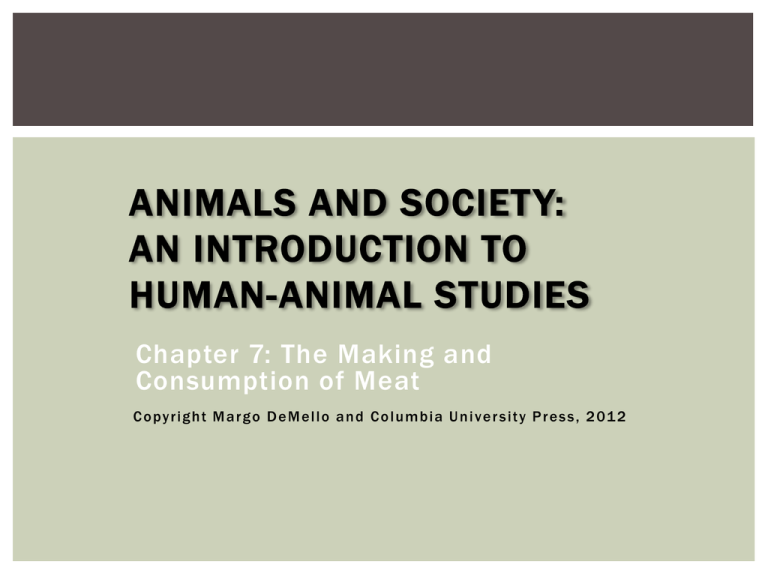
ANIMALS AND SOCIETY: AN INTRODUCTION TO HUMAN-ANIMAL STUDIES Chapter 7: The Making and Consumption of Meat C o py r i g h t M a r g o D e M e l l o a n d C o l um b i a U n i v e r s i t y P r e s s , 2 01 2 MEAT For the great majority of people in this country, the only interaction we have with the animals who became our dinner is the preparation and consumption of them. Separated from the production process by geography and the behind-the-scenes nature of meat production, Americans consume billions of animals each year, without even really recognizing it. We don’t see eating meat as contact with animals; we see it as contact with “food.” The relationship that modern Americans now have to the meat that they consume is very different from the relationship enacted in traditional societies —whether hunting and gathering, pastoral, or agricultural —and even in our own society until about a hundred years ago. MEAT TABOOS Any animal can technically become meat, but ever y society has social rules regarding which animals are edible, and which are not. In general, scholars who have tried to under stand the reasons behind food taboos —which over whelmingly feature meat —have tended to focus on two types of explanations: functional explanations and symbolic ones. In India, for example, cows are taboo to eat, because they are considered sacred to Hindus. Anthropologists generally explain the taboo on cow flesh from an economic standpoint: cows are wor th more alive than dead. Because of their economic value, cows are exalted and protected. Among Jews and Muslims, pigs are considered taboo ( kashrut to Jews and haram to Muslims). Some scholars have explained this by again focusing on the practicalities of pig production: raising pigs in the hot dr y Middle East makes little sense, because of pigs’ need for moisture and shade. Anthropologist Mar y Douglas, on the other hand, explained the Biblical taboo on not just pigs but on all of the animals said to be “abominable” in the Book of Leviticus with an argument that focused on the purity and impurity of cer tain animals. MEAT TABOOS In the US and the West in general, dogs are inedible, because they were initially domesticated as a hunting par tner, and not a food animal, which ultimately led to them attaining the status of pet. Once an animal is defined as a pet, rather than food, it becomes ver y dif ficult for that animal to be consumed, because to be a “pet” is to be considered, at least in par t, family, and eating a member of the family (even an animal) is a symbolic form of cannibalism. In addition, from an economic per spective, it doesn’t make sense to eat an animal which must be fed other animals fir st. However, dogs are famously eaten in China, Vietnam and Korea, as well as in some Pacific Island cultures. Anthropologists generally explain this contradicti on from, again, an economi c per spective. In cultures like the United States, where there is an abundance of animals for consumpti on, dogs are more valuable as hunting par tner s, security, and companionship. They can be consumed, however, in cultures where there are either few other animal resources, or their other ser vices are not highly valued. Symbolic associati ons play a big role in what animals are tabooed. Scavenger animals like vultures are of ten prohibited because of their association with death and disease, as are rats and mice. Sometimes animals, or par ts of animals, are tabooed because they are associated with the poor or with famine. In the United States, for example, organ meats, pigeons, and squirrels are associated with the poor, and are thus not highly valued by middle or upper class Americans. HOW DOES AN ANIMAL BECOME MEAT? Ultimately, in order for an animal to be considered edible, it has to make sense —economic and symbolic sense—for particular animals to be consumed as food in a given society. But how does an animal become meat? HOW DOES AN ANIMAL BECOME MEAT? 1. 2. 3. 4. 5. In order for an animal to become meat, then, the animal has to be considered “edible” Then the animal must be defined as meat. In English -speaking countries, for example, those animals considered edible are known as “livestock:” literally “supply” or “money” that is alive. Once an animal has been defined as one that can be consumed, an animal only becomes meat upon being slaughtered, and then butchered. Hunting cultures, pastoral societies, and farming societies all have specific methods of killing an animal, and specific methods of butchering the animal. Butchering transforms the whole animal into individual par ts, which then become known as “meat.” In the US, animals are born and raised in order to be meat. They are seen as products from their bir th until their death, and their value is based only and entirely on their economic value as meat. So one way that an animal is transformed into meat is through their production in a factor y whose final product is meat. Af ter the animal is butchered, at least in the West, is packaging. This packaging fur ther distances the live animal from the final product, and the consumer from the reality of what they are eating. MEAT CONSUMPTION IN THE PAST Our pre-human ancestor s were most likely scavenger s and gatherer s, and may have even been hunted themselves by wild animals. They would have been primarily vegetarians, who supplemented their diet with the occasi onal dead animal that they could scavenge. With the evolution of Homo Erectus around a million and a half year s ago, our ancestor s became hunter s, eating both big game, while still consuming vegetable matter. As Homo sapiens arose a couple of hundred thousand year s later, our species made their living primarily through hunting of large animals and gathering plants. As the ear th’s climate warmed up about 15,000 year s ago, many large herd animals moved nor th, and people living in the south began to adopt a more generalized economic strategy, focusing less on large animals, and more on small animals, birds, and fish, as well as a variety of grasses, beans, peas and cereals. As time passed, many of the large megafauna ultimately became extinct thanks to overhunting. Hunting and gathering remained the primar y economic activity of all humans until the Neolithic Revoluti on, beginning about 8,000 year s ago, when humans fir st domesticated plants and animals. But whether hunter/gatherer, pastoralist or farmer, most human populations do not eat meat on a regular basis. THE CREATION OF “LIVESTOCK” FROM AUROCH Here animal bodies are transformed through selective breeding to create animals who are tame, easy to breed, easy to feed, and easy to control. THE CREATION OF “LIVESTOCK” TO COW With the ultimate goal being to create animals whose primary purpose is being eaten (with labor and textiles as additional purposes) MODERN MEAT CONSUMPTION It wasn’t until the nineteenth and twentieth centuries that meat consumption became a daily activity, because of a major change in how livestock were raised, and how meat was produced. It also resulted from economic changes related to the rise of industrial capitalism with its emphasis on efficiency, profits, and technological innovation. Industrialization in the eastern United States, combined with huge amounts of available land and new methods of transportation, created a greater demand for meat. Three quarters of our farmland is devoted to raising crops not for humans, but to feed to cattle. This enormous waste of land and resources is simply not possible in most of the world. This new demand for animal products has increased to a point where it can no longer be satiated by the family farm system that emerged thousands of years ago. THE RAILROAD AND MEAT 1861-1865 Changes occurred during the Civil War Railroads decreased need for horses and mules and for stock to be raised where they are consumed Refrigeration in box cars allowed shipping of carcasses to population centers Now animals could be raised in one place, sold at another and consumed at yet another. Change in tastes – beef became most popular. Before the war, pork was the most popular meat (mainly due to ease of storage), but beef became the most popular meat after the war because of refrigeration. MODERN MEAT PRODUCTION AND CONSUMPTION The next development with respect to modern animal-raising techniques was the introduction of methods drawn from industrialization, which can be summed up as large-scale, centralized production and intensive animal rearing, which concentrated animals into small spaces and controlled food, water, and temperatures. MODERN LIVESTOCK Since the 19 th century, animals have become meatproducing machines, manufacture d and maintained for the highest profit. Confined Animal Feeding Operations Creating Livestock Since the early part of the twentieth century, farmers have been experimenting with creating new livestock breeds, via crossbreeding, artificial insemination, and genetic manipulation, in order to maximize size, fat composition, productivity, or other traits. INDUSTRIAL PRODUCTION Large-scale, centralized production, which concentrates animals into small spaces and controls food, water, and temperatures, enables easier health monitoring, and controls “unnecessary” and “inef ficient” animal movements. No outside air, no dirt, no sunlight, and no capacity for natural movement or activities like grooming, play, exercise, unaided reproduction, or the like. Chickens are de-beaked, live in spaces too small to spread their wings Cattle are de-horned, rarely live on pasture Pigs have their tails docked, live in spaces too small to lie down Industrializing Animals To produce the most meat in the shor test amount of time, animal agribusiness now breeds farm animals to grow at unnaturally rapid rates, with radical results to the animal body. These changes have been encouraged by new developments in agricultural science, aimed at improving the productivity of food animals such as the routine use of hormones and antibiotics to keep animals alive, and to encourage fast growth. POLITICAL ECONOMY OF AGRIBUSINESS In the past several decades, virtually every aspect of the meat industry has become increasingly consolidated, with a very small number of companies controlling the markets for eggs, dairy, and milk. The largest 2 percent of factory farms produce more than 40 percent of all farm animals. Today, just four companies —Pilgrim’s Pride, Tyson, Perdue, and Sanderson Farms—produce 58.5 percent of chickens used for meat. Corporate giants like Cargill, Tyson Foods, IBP, and ConAgra are now “vertically integrated,” owning the facilities that produce the animals, the feedlots to fatten them, and the meatpacking facilities to slaughter them and package the meat. This type of integration allows massive companies to control every aspect of production, making it nearly impossible for smaller farms to compete. The government, via the USDA, plays a major role in promoting meat consumption in the US PILGRIM’S PRIDE Pilgrim's Pride is the fifth largest poultry producer in the country. The company owns the breeder farms, the egg hatcheries, and the grow-out farms, as well as the trucks that ship the chickens to the processing plants, also owned by Pilgrim’s Pride, that kill and process them. It also owns the feed mills that provide the food for the chickens, as well as separate egg farms which provide eggs. SLAUGHTERHOUSE WORKERS Meat is cheap in part because it is produced cheaply—by workers who are exploited, including illegal immigrants, whose work conditions are horrific and who are fired at the first sign of injury or complaint CULTURAL IMPLICATIONS OF MEAT EATING Animals suf fer through meat production Society is concerned with animal well -being Animal rights groups have made factory farm practices public knowledge this has prompted a response from the food industry. Resulted in industry changes McDonald’s Animal Welfare Guiding Principles Wendy’s Animal Welfare Auditing Program Other companies now getting on board with volunteer animal welfare programs LAWS AND REGULATIONS The 28 Hour Law Mandates that animals being transported be given food and water after 28 hours Originally defined to only be by rail; only in 2005 did the USDA finally agree to extend the law to trucking Humane Methods of Slaughter Act 1958 Mandates stunning before slaughter Excludes rabbits and poultry from protection Food Safety and Inspection Service (FSIS) enforces the Act Very few inspectors for all of the facilities in the US LEGISLATIVE CHANGES Whether through typical legislative channels or as a result of a ballot initiative, several states have enacted laws that are concerned with farm animal welfare. Most require that farm animals be given a certain amount of space. The broadest of all the laws is California’s Prevention of Farm Animal Cruelty Act (Prop 2), passed in 2008, which “prohibits the cruel confinement of farm animals in a manner that does not allow them to turn around freely, lie down, stand up, and fully extend their limbs.” It applies to all farm animals, including veal calves, chickens, and pigs: all of the animals who are generally kept in conditions that prevent lying down or moving around. Essentially bans veal crates, gestation crates and battery cages HEALTH IMPLICATIONS OF MEAT EATING Meat consumption is correlated with a whole host of human health problems. Food is contaminated at the slaughterhouse, where rapid line speeds increase the exposure of meat to feces, causing dangerous bacteria and viruses to enter the meat supply. Each year, US meat producer s use 24.6 million pounds of antibiotics for healthy animals alone, resulting in antibiotic resistance in humans. Meat consumption is also correlated with higher rates of cancer, hear t disease, and osteoporosis. The most sensational factor y farm -related illnesses are mad cow disease, swine flu, and avian influenza, which have captured headlines and captivated public attention. ENVIRONMENTAL IMPLICATIONS OF MEAT EATING Industrial agriculture uses huge amounts of water, energy, and industrial chemicals; increasing pollution in the land, water and atmosphere. Herbicides, insecticides, fer tilizer s, and animal waste products are accumulating in ground and sur face waters. Damage to fisheries Water polluted with animal waste (1.5 billion tons per year) Water polluted with pesticides and fertilizer Increased ozone pollution and global warming from heavy use of fossil fuels as well as the release of methane, carbon dioxide and nitrous oxide from cattle production Deforestation of tropical rainforests to make way for livestock grazing Loss of topsoil due to overuse Landfills overwhelmed with solid waste ENVIRONMENTAL IMPLICATIONS OF MEAT EATING 90% of Soybeans and 80% of Corn: More than 90% of soybean and 80% of corn grown in the United States is used to feed animals being raised for human food. 70% of Land: In the Amazon, 70%of once -forested land is now used for grazing cattle. 1 8% of Greenhouse Gas Emissions: Animal agriculture is responsible for 1 8% of greenhouse gas emissions —more than all the planes, trains, ships, and automobiles in the world combined. Animal agriculture is responsible for 65% of nitrous oxide emissions (a gas with a global warming potential [GWP] 296 times that of CO 2 ), 37% of methane (GWP 23 times that of CO 2 ), and 9% of CO 2 . 37% of Pesticides and 50% of A ntibiotics: Animal agriculture uses 37% of all pesticides and 50% of antibiotics and contributes enormously to water pollution, endangering human and nonhuman animal health and life. 200 times m ore water: It takes an average of 25 gallons of water to produce a pound of wheat. It takes 5,214 gallons of water to produce a pound of beef. MEAT AND POWER Many scholars have pointed out the links between the consumption of meat and power. As Plutarch noted in the first century, while most people in ancient Rome rarely ate meat, elites not only ate huge amounts of it, but wasted huge amounts of it as well. Feminist scholar Carol Adams also notes that people with power have always eaten meat, and in particular, meat eating tends to be associated with masculinity. Women, children, the poor, and minorities often eat what is thought to be second class food: vegetables, grains, and fruit. But while women often don’t eat meat, or eat it rarely, they are expected to prepare it for their husbands, sons and fathers. The Chinese and the Japanese were considered by Europeans to be “rice eaters,” and the Irish were potato eaters —all of these characterizations made them inferior to the English, and justified their conquering. According to Adams, meat is the ultimate male product, because it is the ultimate conquest of culture over nature. ETHICS AND MEAT EATING Despite the fact that nearly 10 billion animals are raised and killed for food each year in the United States, there are vir tually no laws that protect them. Most state cruelty codes exempt common agricultural practices, so cruelty that would result in criminal prosecution if the victim were a dog or a cat is not defined as cruelty in farming. Most people do not kill the animals they ate, and they cer tainly do not eat the animals raw; instead, they transform them via butchering and cooking them Another way that we avoid thinking about the meat that we consume is by our naming practices. Many forms of meat have names that conceal the animal that they come from: pork and not pig; beef and not cow. As feminist scholar Carol Adams points out, the animal is the absent referent in meat: without the animal there is no meat yet they are absent from meat because they have been transformed, via slaughtering, butchering, and marketing, into food. The animal is absent because it is dead, it is absent because we talk about animals dif ferently when we eat them, and it is absent because animals become metaphors for describing something else: “I felt like a piece of meat.”

